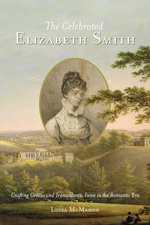Lucia McMahon on Women's History Month
Lucia McMahon on Women's History Month

As we celebrate Women’s History Month this year, I want to take the opportunity to reflect on the long legacy of women as writers, scholars, and intellectuals. As a London essayist noted in an 1813 issue of The Quarterly Review: “The mere existence of three or four extraordinary women in a country is of comparatively little value.” Cultural critics could dismiss such individual examples as exceptional anomalies, rather than as representative trends. “Within the last twenty years,” however, there were “more women distinguished for their literary talents. . . than in the twenty centuries that had elapsed.” This author regarded such a “great and increasing number of educated, intelligent, accomplished women” as proof of the improved “character and condition of the female sex.” Such “rapid progress” sparked contemplation: “the more we consider the subject, the more we shall be surprised both at how much they have done, and at how little was done before them.”
It’s worth noting that even commentators who expressed support for women’s intellectual achievements as our modern age dawned were “surprised” by these developments. But what exactly was so surprising about the existence of talented, educated women? Why would it be regarded as noteworthy that many women demonstrated impressive intellectual capacities, especially when given expanded opportunities and support? And what was the tipping point: If “three or four extraordinary women” did little to change societal norms and expectations, how many smart women were needed for them to be regarded as representative, rather than surprising?
By labeling women’s achievements as surprising, extraordinary, and remarkable, nineteenth-century commentators reinforced gendered constructions of knowledge, genius, and intellectual capacity. Although he expressed approval of women’s education, this 1813 essayist insisted that women’s “minds are of a less bold, original, and independent cast.” Like other critics, he also warned that that women’s pursuit of knowledge, “much as we value it,” should never occur “at their expense of their social or domestic virtues,” or “charm of the female character.” Even the most accomplished women, then, were told that their intellects were inferior to men, and that education should never distract from their domestic duties.
This seemingly incompatibility between women’s intellectual capacities and their prescribed gender roles meant that all educated women on either side of the Atlantic tended to be treated as somewhat unusual and suspicious. “It is the temper of the times to look on a learned woman with a kind of abhorrent awe,” another essayist had confessed in the Virginia-based National Magazine in 1800, describing “the acquirement of knowledge in a female, as incompatible with that delicacy of sentiment.” Such frameworks created contested legacies with enduring resonance.
Despite their growing numbers, women writers continued to be regarded as a surprising – and problematic – presence in the literary marketplace. Nathaniel Hawthorne’s famous complaint about the “damned mob of scribbling women” represents just one voice in a chorus of critique that echoed across nineteenth-century cultures of print. Critics bemoaned that there were too many women writers, while also insisting that most lacked “true” talent or genius. Any individual woman who somehow managed to receive positive acclaim was treated as exceptional or extraordinary. Over time, these attitudes contributed to the notion that it was anomalous and troubling for any woman to engage in scholarly and literary pursuits, even as more and more women were doing so.
Scholars have spent decades researching and recovering women’s intellectual productions and lived experiences, yet too often, we continue to label talented and impressive women as extraordinary or remarkable. A key question remains unanswered: how many notable women do we need to find before we stop being surprised? Perhaps we might consider that it is our gendered assumptions and stereotypical ideas that need revising?
In my new book, The Celebrated Elizabeth Smith: Crafting Genius and Transatlantic Fame in the Romantic Era, I seek to reframe the ways that both nineteenth-century critics and contemporary observers have tended to categorize women’s ambitions and accomplishments. Born in 1776 in northeast England, Elizabeth Smith was a young woman with seemingly boundless intellectual curiosity who spent countless hours studying astronomy, botany, mathematics, history, and poetry. With little formal training, Smith mastered several languages, including Latin, Greek, Hebrew, French, Spanish, German, and Arabic. She was also an adventurous traveler who rambled through scenic landscapes, explored historic ruins, and literally climbed mountains.
Elizabeth Smith certainly possessed scholarly talents and an adventurous spirit, but did those traits make her exceptional or extraordinary? The mere existence of an intelligent, capable woman should not be noteworthy or surprising, particularly in an era that produced many “distinguished” women. If there is anything atypical about Elizabeth Smith, it is not that she was an accomplished scholar or a curious wanderer, but rather the contours of her literary “afterlife.”
After her death, Elizabeth Smith gained transatlantic fame for her impressive intellectual abilities, which—even more impressively—appeared to remain suitably tempered by her modesty, piety, and femininity. Throughout the nineteenth century, numerous writers venerated Smith as a “rare” specimen: “She was not only a scholar, but a woman—omni laude cumulate.” Cultural commentators saw Smith as a notable exception to the widespread belief, as the Boston Review put it in 1810, “that every advance in abstruse science or profound learning by a lady is gained at the expense of domestick honour—of household good.” Unlike prevailing stereotypes of educated women as vain, pedantic, and unfeminine, Elizabeth Smith was praised as both accomplished and acceptable. Her exceptional, unblemished character was celebrated, but also used to make judgements against other educated women who would inevitably fail to meet this elusive standard.
Rather than trying to prove that Elizabeth Smith was a genius with remarkable intellectual powers (she was indeed—surprise?!), her life and legacy encourage us to challenge and dismantle the gendered assumptions that have, for too long, been used to measure and critique women’s accomplishments—up to and including in our present day. Perhaps when we are no longer surprised by so many historical examples of talented and remarkable women, we can fully acknowledge “how much they have done.” As we reflect on women’s many achievements across time and space, let’s leave outdated stereotypes behind and envision inspired possibilities instead.
Lucia McMahon
William Paterson University
QuickLinks
Find a BookFor Our AuthorsRights and PermissionsRotunda Digital ImprintSupport UVA PressCareer OpportunitiesWalker Cowen Memorial PrizePrivacy PolicyContact Us
- P.O. Box 400318 (Postal)
- Charlottesville, VA 22904-4318
- 210 Sprigg Lane (Courier)
- Charlottesville, VA 22903-2417
- 434 924-3468 (main)
- 1-800-831-3406 (toll-free)
- 434 982-2655 (fax)

the future
of publishing
Affiliates



